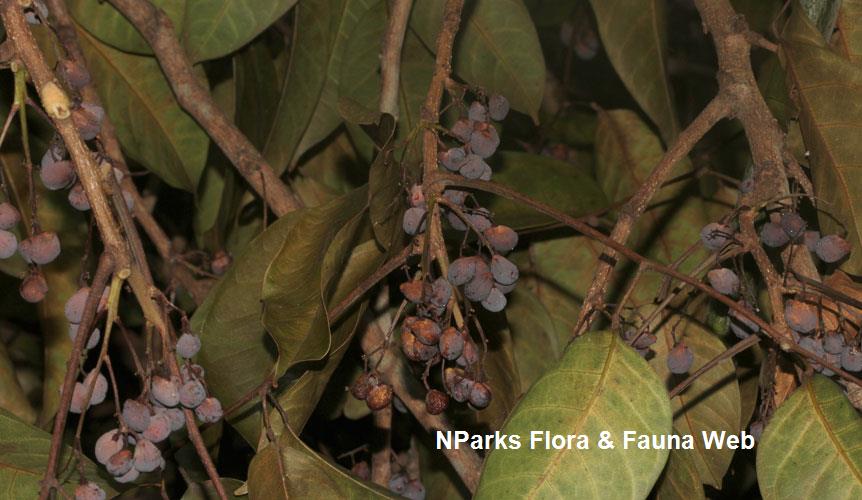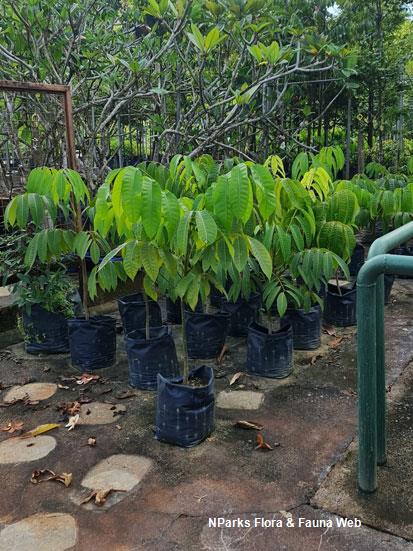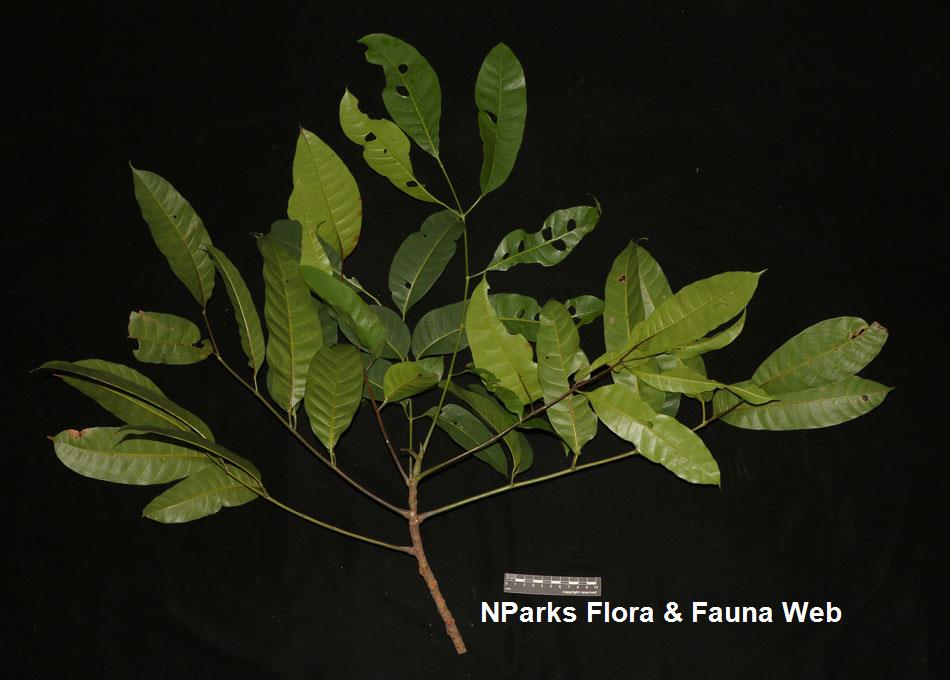
Back
Santiria laevigata Blume
| Family Name: | Burseraceae |
| Common Name: | Kedondong Kerantai Lichin, Kedondong Gergaji Daun Licin, Kedondong, Smooth-leaved Santiria |
Santiria laevigata or Kedondong Gergaji Daun Licin is a tree native to Singapore. Growing to 30 m tall, it has an aromatic bark described to have mango-like or turpentine smell. Clear to creamy white sticky resins exudates from the trunk. Leaves are odd-pinnate, leathery between 5 - 11 leaflets. Terminal buds are covered in resin, drying black and shiny. Flowers are dioecious, small up to 2 mm long, 3-petalled, green to white. The fruit is an irregular globose to elliptic drupe, flattened on one side. Upon maturity, it turns yellow to red and finally black.
Name
Classifications and Characteristics
| Plant Division | Angiosperms (Flowering Seed Plants) (Dicotyledon) |
|---|---|
| Plant Growth Form | Tree (Medium (16m-30m), Big (>30m)) |
| Maximum Height | 30 m |
Biogeography
| Native Distribution | Peninsular Malaysia, Sumatra, Borneo, central Sulawesi and the Philippines (Mindanao), Singapore |
|---|---|
| Native Habitat | Terrestrial (Freshwater Swamp Forest, Primary Rainforest, Secondary Rainforest) |
| Preferred Climate Zone | Tropical |
| Local Conservation Status | Native to Singapore (Vulnerable (VU)) |
Description and Ethnobotany
| Growth Form | It is a medium to large sized tree that grows to 30 m tall. Buttresses often present. The bark is described to be strongly aromatic, resembling mango-like or turpentine smell. Clear to creamy white sticky resins exudates from the trunk. |
|---|---|
| Foliage | Leaves are odd-pinnate with 1 leaflet at the end. Each leaf has 5 - 11 leathery, elliptic to oblong leaflets, 5-35.5 cm long, 3-10 cm wide. Lateral veins are nearly right angled to the midrib when matured. Young leaflets often have curving or arching to looping lateral veins. The stalks are swollen on both ends, dries blackish. Similarly, its terminal buds are covered in resin, often drying black and shiny. |
| Flowers | Flowers are dioecious where the female and male flowers are produced on separate individuals. Flower borne on an inflorescence, mostly found along the axils, covered in hairs when young. They are 3-petalled, green to white with 6 stamens measuring up to 2 mm long. |
| Fruit | The fruit is an irregular globose to elliptic drupe that is flattened on one side, measuring 10 - 20 mm long by 7 - 20 mm wide. Upon maturity, the fruit turns from yellow to red and finally black. |
| Habitat | Occurs in forest, both dry and swampy areas including lowland peat swamp forests up to 1200 - 1500 m altitude. <1&2> |
| Cultivation | Santiria laevigata thrive under full sun conditions, intolerant to waterlogged conditions. It can be propagated by seed. |
| Ethnobotanical Uses | Edible Plant Parts : Edible Fruits |
Landscaping Features
| Desirable Plant Features | Fragrant (Bark) |
|---|
Plant Care and Propagation
| Light Preference | Full Sun |
|---|---|
| Water Preference | Moderate Water |
| Plant Growth Rate | Moderate |
| Rootzone Tolerance | Fertile Loamy Soils, Moist Soils |
| Propagation Method | Seed |
Foliar
| Foliage Retention | Evergreen |
|---|---|
| Mature Foliage Colour(s) | Green |
| Mature Foliage Texture(s) | Leathery |
| Foliar Type | Compound (Odd-Pinnate) |
| Foliar Arrangement Along Stem | Spiral |
| Foliar Attachment to Stem | Petiolate |
| Foliar Shape(s) | Non-Palm Foliage (Elliptical, Oblong) |
| Foliar Venation | Reticulate |
| Foliar Margin | Entire |
| Foliar Apex - Tip | Acuminate, Acute |
| Foliar Base | Cuneate, Rounded / Obtuse |
Non - Foliar and Storage
| Stem Type & Modification | Woody |
|---|---|
| Root Type | Underground |
Floral (Angiosperm)
| Flower & Plant Sexuality | Unisexual Flowers , Dioecious |
| Flower Colour(s) | White, Green |
|---|
| Flower Grouping | Cluster / Inflorescence |
| Flower Location | Axillary |
| Flower Symmetry | Radial |
| Flowering Habit | Polycarpic |
Fruit, Seed and Spore
| Mature Fruit Colour(s) | Black |
|---|---|
| Fruit Classification | Simple Fruit |
| Fruit Type | Fleshy Fruit , Drupe |
References
| References | <1> Lemmens, R.H.M.J. et al. (1995). PROSEA Timber trees: Minor commercial timbers, vol. 5(2). Leiden: Backhuys Publishers. pp. 421. <2> Seah, W.W. et al. (2019). Towards a field guide to the trees of the Nee Soon Swamp Forest (V): Burseraceae, Nature in Singapore 12: 30. |
|---|
Image Repository
Others
| Master ID | 30361 |
|---|---|
| Species ID | 4670 |
| Flora Disclaimer | The information in this website has been compiled from reliable sources, such as reference works on medicinal plants. It is not a substitute for medical advice or treatment and NParks does not purport to provide any medical advice. Readers should always consult his/her physician before using or consuming a plant for medicinal purposes. |


